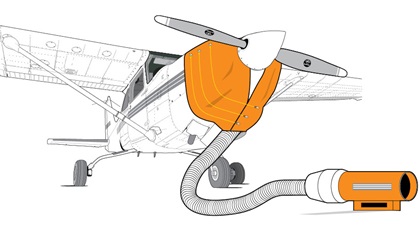
One preheating option uses an electric heating pad attached to the oil sump (top). Another directs a blast of hot air at the engine from a portable unit (below).
Illustrations by Steve Karp
When temperatures drop, it’s time to heat things up. And that goes for a piston airplane’s engine as well as for everything else. Piston engines use aluminum parts to save weight—the crankcase, the pistons, and cylinder heads. Parts that require greater strength—cylinder barrels, connecting rods, crankshaft—are made of steel, chrome, or other metals. These metals expand and contract with temperature changes, but aluminum and steel don’t expand and contract at the same rate.
When temperatures are stable, the clearances between the engine components are stable. But when they get cold and then must expand during startup, the tolerances between the parts could get tight enough to rub, bind, and cause damage.
That’s one reason to warm things up. Another is oil. It can get thick and heavy during cold temperatures, and it won’t lubricate as effectively on start-up.
So, a piston engine should be warmed in cold temperatures, long before you turn on the master switch and crank the propeller. There are a couple ways to accomplish this.
The first—and the one you most likely have seen—is with a portable preheater. Commonly used by flight schools and fixed-base operators, portable preheaters use propane or electricity (or both) to direct a blast of hot air at the engine through the front of the cowl or at the bottom.
A popular option among aircraft owners is to install a preheater directly on the airplane. These units involve small electric pads attached to the oil sump, or in some cases to the engine case and cylinders. The preheater can be plugged in hours before engine start, and can even be operated remotely so that you can activate it before you’ve left for the airport.

 Hangars are great, as is access to an electrical outlet to preheat an airplane. But when you have neither, you’ve got to be resourceful. Pilots have been known to build portable heaters using camp stoves and flexible ducting. Got electricity? Get a heat gun, attach some ducting, and heat away—but always monitor any home-grown heating solution. Find more ideas on YouTube.
Hangars are great, as is access to an electrical outlet to preheat an airplane. But when you have neither, you’ve got to be resourceful. Pilots have been known to build portable heaters using camp stoves and flexible ducting. Got electricity? Get a heat gun, attach some ducting, and heat away—but always monitor any home-grown heating solution. Find more ideas on YouTube.